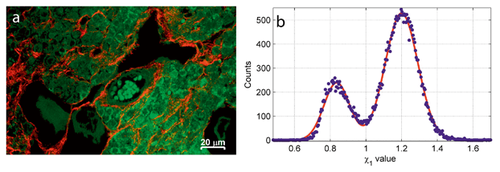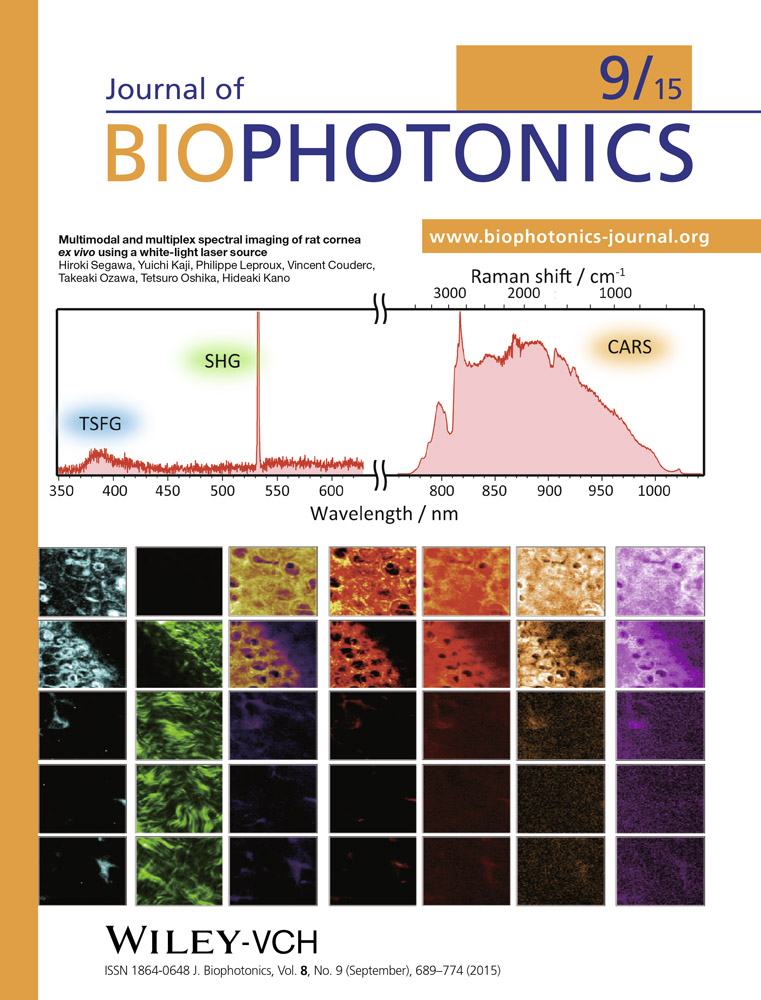Polarization second harmonic generation microscopy provides quantitative enhanced molecular specificity for tissue diagnostics
Corresponding Author
Rajesh Kumar
Department of Physics, Norwegian University of Science and Technology (NTNU), N-7491 Trondheim, Norway
Corresponding author: e-mail: [email protected]
Search for more papers by this authorElisabeth I. Romijn
Department of Physics, Norwegian University of Science and Technology (NTNU), N-7491 Trondheim, Norway
Search for more papers by this authorAndreas Finnøy
Department of Physics, Norwegian University of Science and Technology (NTNU), N-7491 Trondheim, Norway
Search for more papers by this authorCatharina L. Davies
Department of Physics, Norwegian University of Science and Technology (NTNU), N-7491 Trondheim, Norway
Search for more papers by this authorMagnus B. Lilledahl
Department of Physics, Norwegian University of Science and Technology (NTNU), N-7491 Trondheim, Norway
Search for more papers by this authorCorresponding Author
Rajesh Kumar
Department of Physics, Norwegian University of Science and Technology (NTNU), N-7491 Trondheim, Norway
Corresponding author: e-mail: [email protected]
Search for more papers by this authorElisabeth I. Romijn
Department of Physics, Norwegian University of Science and Technology (NTNU), N-7491 Trondheim, Norway
Search for more papers by this authorAndreas Finnøy
Department of Physics, Norwegian University of Science and Technology (NTNU), N-7491 Trondheim, Norway
Search for more papers by this authorCatharina L. Davies
Department of Physics, Norwegian University of Science and Technology (NTNU), N-7491 Trondheim, Norway
Search for more papers by this authorMagnus B. Lilledahl
Department of Physics, Norwegian University of Science and Technology (NTNU), N-7491 Trondheim, Norway
Search for more papers by this authorAbstract
Due to specific structural organization at the molecular level, several biomolecules (e.g., collagen, myosin etc.) which are strong generators of second harmonic generation (SHG) signals, exhibit unique responses depending on the polarization of the excitation light. By using the polarization second harmonic generation (p-SHG) technique, the values of the second order susceptibility components can be used to differentiate the types of molecule, which cannot be done by the use of a standard SHG intensity image. In this report we discuss how to implement p-SHG on a commercial multiphoton microscope and overcome potential artifacts in susceptibility (χ) image. Furthermore we explore the potential of p-SHG microscopy by applying the technique to different types of tissue in order to determine corresponding reference values of the ratio of second-order χ tensor elements. These values may be used as a bio-marker to detect any structural alterations in pathological tissue for diagnostic purposes.
Supporting Information
| Filename | Description |
|---|---|
| jbio201400086-sup-0001-author-biographies.pdfPDF document, 267.4 KB | Author biographies |
Please note: The publisher is not responsible for the content or functionality of any supporting information supplied by the authors. Any queries (other than missing content) should be directed to the corresponding author for the article.
References
- 1F. Helmchenand W. Denk, Nature methods 2 (12), 932–940 (2005).
- 2P. Friedl, K. Wolf, G. Harms, and U. H. von Andrian, Biological Second and Third Harmonic Generation Microscopy (John Wiley and Sons, Inc., 2001).
- 3T. Abraham, J. A. Hirota, S. Wadsworth, and D. A. Knight, Pulmonary Pharmacology and Therapeutics 24 (5), 487–496 (2011).
- 4W. Mohler, A. C. Millard, and P. J. Campagnola, Methods 29 (1), 97–109 (2003).
- 5K. Schenke-Layland, Journal of Biophotonics 1 (6), 451–462 (2008).
- 6M. Rivard, K. Popov, C. A. Couture, M. Laliberte, A. Bertrand-Grenier, F. Martin, H. Pepin, C. P. Pfeffer, C. Brown, L. Ramunno, and F. Legare, Journal of Biophotonics 7 (8), 638–646 (2014).
- 7A. T. Yeh, M. J. Hammer-Wilson, D. C. VanSickle, H. P. Benton, A. Zoumi, B. J. Tromberg, and G. M. Peavy, Osteoarthritis and Cartilage 13 (4), 345–352 (2005).
- 8W. L. Chen, T. H. Li, P. J. Su, C. K. Chou, P. T. Fwu, S. J. Lin, D. Kim, P. T. C. So, and C. Y. Dong, Applied Physics Letters 94 (18), 183902 (2009).
- 9S. W. Chu, S. Y. Chen, G. W. Chern, T. H. Tsai, Y. C. Chen, B. L. Lin, and C. K. Sun, Biophysical Journal 86 (6), 3914–3922 (2004).
- 10P. J. Su, W. L. Chen, T. H. Li, C. K. Chou, T. H. Chen, Y. Y. Ho, C. H. Huang, S. J. Chang, Y. Y. Huang, H. S. Lee, and C. Y. Dong, Biomaterials 31 (36), 9415–9421 (2010).
- 11S. V. Plotnikov, A. C. Millard, P. J. Campagnola, and W. A. Mohler, Biophysical Journal 90 (2), 693–703 (2006).
- 12T. Hompland, A. Erikson, M. Lindgren, T. Lindmo, and C. de Lange Davies, Journal of Biomedical Optics 13 (5), 054050-1–054050-11 (2008).
- 13R. Ambekar, T. Y. Lau, M. Walsh, R. Bhargava, and K. C. Toussaint, Biomed. Opt. Express 3 (9), 2021–2035 (2012).
- 14P. S. Hu, C. M. Hsueh, P. J. Su, W. L. Chen, V. A. Hovhannisyan, S. J. Chen, T. H. Tsai, and C. Y. Dong, IEEE Journal of Selected Topics in Quantum Electronics 18 (4), 1326–1334 (2012).
- 15P. Campagnola, Analytical Chemistry 83 (9), 3224–3231 (2011).
- 16S. Tang, W. Jung, D. McCormick, T. Xie, J. Su, Y.-C. Ahn, B. J. Tromberg, and Z. Chen, Journal of Biomedical Optics 14 (3), 034005-1–034005-7 (2009).
- 17L. Fu, A. Jain, C. Cranfield, H. Xie, and M. Gu, Journal of Biomedical Optics 12 (4), 040501-1–040501-3 (2007).
- 18J. C. Jungand M. J. Schnitzer, Opt. Lett. 28 (11), 902–904 (2003).
- 19I. A. Roldan, S. Psilodimitrakopoulos, P. L. Alvarez, and D. Artigas, Opt. Express 18 (16), 17209–17219 (2010).
- 20S. Psilodimitrakopoulos, D. Artigas, G. Soria, I. A. Roldan, A. M. Planas, and P. L. Alvarez, Opt. Express 17 (12), 10168–10176 (2009).
- 21S. Psilodimitrakopoulos, S. Santos, I. Amat-Roldan, A. K. N. Thayil, D. Artigas, and P. Loza-Alvarez, J. Biomedical Optics 14 (1), 014001-1–014001-11 (2009).
- 22P. S. Hu, A. Ghazaryan, V. Hovhannisyan, S. J. Chen, Y. F. Chen, C. S. Kim, T. H. Tsai, and C. Y. Dong, Journal of Biomedical Optics 18 (3), 031102 (2012).
- 23X. Chen, O. Nadiarynkh, S. Plotnikov, and P. J. Campagnola, Nature Protocols 7, 654–669 (2012).
- 24T. Yasui, Y. Takahashi, S. Fukushima, Y. 0gura, T. Yamashita, T. Kuwahara, T. Hirao, and T. Araki, Opt. Express 17 (2), 912–923 (2009).
- 25C. K. Chou, W. L. Chen, P. T. Fwu, S. J. Lin, H. S. Lee, and C. Y. Dong, Journal of Biomedical Optics 13 (1), 014005-1–014005-7 (2008).
- 26B. Richardsand E. Wolf, Proceedings of the Royal Society of London. Series A. Mathematical and Physical Sciences 253 (1274), 358–379 (1959).
- 27E. Yewand C. Sheppard, Optics Communications 275 (2), 453–457 (2007).
- 28S. Saha, P. Ghosh, D. Mitra, S. Mukherjee, S. Bhattacharya, and S. S. Roy, Cell Physiol Biochem. 19 (1–4), 67–76 (2007).
- 29C. Berkholtz, B. Lai, T. K. Woodruff, and L. D. Shea, Histochemistry and Cell Biology 126 (5), 583–592 (2006).
- 30F. Vanzi, L. Sacconi, R. Cicchi, and F. S. Pavone, Journal of Biomedical Optics 17 (6), 060901-1–060901-8, (2012).
- 31B. Lopez, A. Gonzalez, and J. Diez, Circulation 121 (14), 1645–1654 (2010).
- 32B. L. Salazar, S. R. Albniz, T. A. Guedn, A. G. Miqueo, R. Querejeta, and J. D. Martnez, Rev. Esp. Cardiol. 59 (10), 1047–1057 (2006).
- 33H. A. Wieland, M. Michaelis, B. J. Kirschbaum, and K. A. Rudolphi, Nature Reviews Drug Discovery 4, 331–344 (2005).
- 34A. Fraser, U. Fearon, R. C. Billinghurst, M. lonescu, R. Reece, T. Barwick, P. Emery, A. R. Poole, and D. J. Veale, Arthritis & Rheumatism 48 (11), 3085–3095 (2003).
- 35A. R. Poole, M. Kobayashi, T. Yasuda, S. Laverty, F. Mwale, T. Kojima, T. Sakai, C. Wahl, S. El-Maadawy, G. Webb, E. Tchetina, and W. Wu, Annals of the Rheumatic Diseases 61 (2), ii78–ii81 (2002).
- 36M. R. Tsai, C. H. Chen, and C. K. Sun, Proc. SPIE 7183, 71831V-1–71831V-10 (2009).
- 37T. A. Theodossiou, C. Thrasivoulou, C. Ekwobi, and D. L. Becker, Biophysical Journal 91 (12), 4665–4677 (2006).
- 38R. Kumar, K. M. Grønhaug, E. l. Romijn, J. O. Drogset, and M. B. Lilledahl, Proc. SPIE 9129, 91292Z-1–91292Z-9 (2014).
- 39R. Kleemann, D. Krocker, A. Cedraro, J. Tuischer, and G. Duda, Osteoarthritis and Cartilage, 13 (11), 958–963 (2005).
- 40R. E. Outerbridge, Journal of Bone & Joint Surgery, British Volume 43 (B4), 752–757 (1961).
- 41I. Amat-Roldan, S. Psilodimitrakopoulos, E. Eixarch, I. Torre, B. Wotjas, F. Crispi, F. Figueras, D. Artigas, P. Loza-Alvarez, and E. Gratacos, Proc. SPIE 7367, 73670O-1–73670O-7 (2009).
- 42J. Bella, M. Eaton, B. Brodsky, and H. M. Berman, Science 266 (5182), 75–81 (1994).





